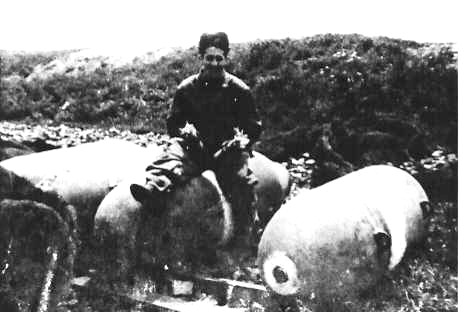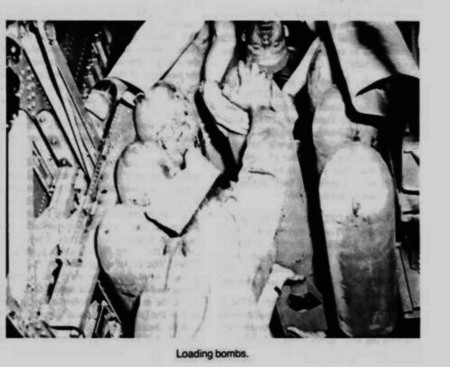WAR STORIES:
AN ORDNANCE MAN'S STORY by Adolph Cello
Featured in the February 1986 issue of Contrails.

PFC
Adolph Cello, 526th Squadron Ordannce Detachment, 379th
BG(H), sitting on a 1,000lb bomb holding two tail fuses.
Circa: 1943-45.
A Bombardment Group airfield
of the 8th Air Force was essentially a self-contained
community. The servicemen who populated it represented a
wide variety of Military Occupational Specialists other
than fliers. All of them played a cooperative role in
the successful operation and maintenance of a United
States Army Air Force bomber base so the job of
effectively bombing enemy targets could be accomplished.
Adolph Cello served as a PFC in the 526th Squadron
Ordnance detachment for most of the time the 379th was
operational at Kimbolton. He tells what his work was
like. He finished his service in a different role that
will be revealed in his story. Enlisting in the service
on November 4, 1942, I had six months of basic training
including ordnance school at various camps. I was
shipped out on the Aquitania May 9, 1943, destination
unknown. After a number of days at sea the ship docked
in the Firth of Clyde near Glasgow, Scotland. From there
we boarded a train that took us to Kimbolton where we
were assigned to Nissen huts.
The following day some men pulled guard duty and others
KP. A few days later our ordnance officer, Lt. H. B.
McClanahan, assigned us to our duties. We went to the
bomb storage area and lined up each bomb according to
poundage. Completing this task, the bombs had to be
camouflaged. Fuses were stored in a different area. The
routine when it came time to load bombs aboard the B-17s
went like this: We were awakened at an early hour in the
morning. If some of the fellows had just gotten back
from pass, you hear a bit of grumping. We got into
our trucks and drove to the storage site to load bombs
and fins on trailers. Two men were assigned to a plane.
Rain made the site very muddy and the bitter cold made
the bombs very difficult to handle. Fog made it somewhat
rough since we had to drive slowly to stay on the roads.
When we got to the runways we had to be careful that we
didn't damage any planes. We had to use an energizer
that was plugged into the belly of the plane since we
weren't allowed to use the planes batteries. One of
us went into the cockpit to open the bomb bay doors and
snap the lights on in the bomb bay. We then shoved the
bomb trailer under the bomb bay doors. Two armorer men
were assigned to a B- 17 to set up the crank to lower
the cable to the bomb trailer and a strap had to be
placed under the bomb. The cable was hooked to the strap
and the armorers had to crank the bomb to the top.
Ordnance men put the fins on the bombs that were hung on
both sides of the bomb bay. After the planes were loaded
the section chief, a Tech Sergeant, delivered
 fuses
to each plane. The nose and tail fuse would be inserted
and the arming wire was put through the fuses that was
then placed with a safety pin. If the mission was
scrubbed we returned to the planes and disarmed all
fuses, removed the bombs and returned them to the
storage site. By the time we got through it usually was
daylight. We were so exhausted that some of us hit the
sack instead of going to chow.
fuses
to each plane. The nose and tail fuse would be inserted
and the arming wire was put through the fuses that was
then placed with a safety pin. If the mission was
scrubbed we returned to the planes and disarmed all
fuses, removed the bombs and returned them to the
storage site. By the time we got through it usually was
daylight. We were so exhausted that some of us hit the
sack instead of going to chow.
Armorer
men were the last ones off the plane. They had to make
sure everything was in working order for the planes
takeoff when a mission was "Go!" Came the day when
rumors were going around that the 379th was going to be
deactivated. We were going to get a furlough to go home
and then go to Japan, so it was said. Responding to a
roll call not too long after rumors about the Triangle K
Groups future started to circulate, my name was
called. The next day I was told to report to an infantry
division in England. Upon arriving, the infantrymen were
calling me a glamour boy because they saw an 8th Air
Force patch on my sleeve and my usual haircut. That
changed quickly: I got a crew cut, a change of uniform
and combat boots. I went through two weeks of infantry
training and then got a 24 hour pass. I returned to
Kimbolton to visit the boys. When they saw me in my
infantry uniform, combat boots and crew cut, they could
hardly believe it. They arranged a party and the next
day we said our good-byes. The day following the return
to my infantry unit, the U.S. Navy took me and my "new"
buddies across the English Channel and we landed
somewhere in France. I went through five major battles
and stopped at the Siegfried line. A few days later I
was transferred to the 989th Anti-aircraft outfit. With
two and one half years overseas and the war over, I was
sent home under the point system. I landed in Boston and
was discharged from Fort Dix, New Jersey on November 7,
1945.